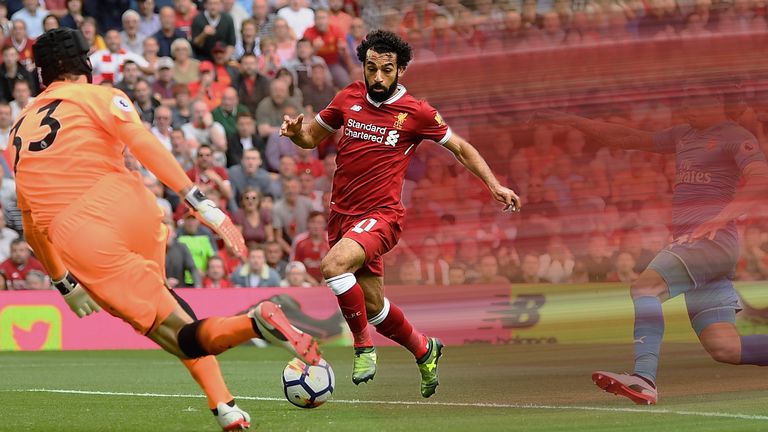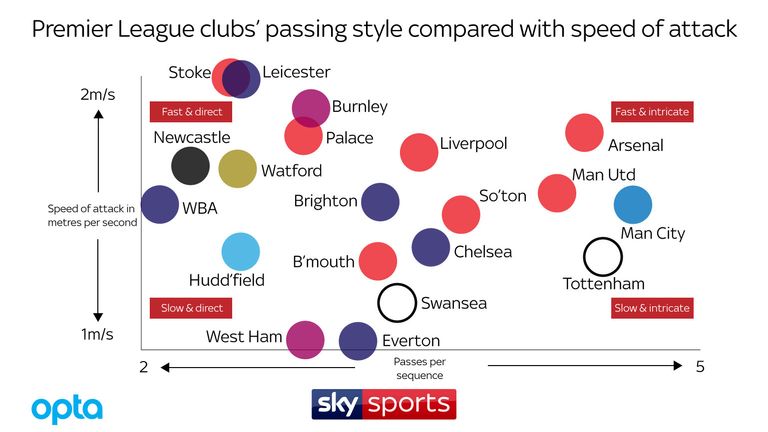Lightning Liverpool and Premier League playing styles
Tuesday 5 September 2017 12:39, UK
Examining Liverpool's rapid counter-attacks and contrasting Premier League playing styles with new Opta data...
Gary Neville described Liverpool's performance in their 4-0 win over Arsenal as "scintillating" - and their speed in attack will be a real worry for Manchester City boss Pep Guardiola ahead of Saturday's Sky Live showdown.
Reds manager Jurgen Klopp revealed he was eager to add more pace to his squad when Mo Salah was unveiled this summer and the threat of Liverpool's lightning counter-attacks was demonstrated by the new signing's breakaway goal against the Gunners.
The Egyptian hit the net just 12 seconds after an Arsenal corner to make it 3-0 and Opta recorded the speed of Liverpool's move downfield as 9.9 metres per second. That makes it the fastest move leading to a goal in the Premier League so far this season.
But it wasn't a one-off. Of the fastest moves leading to open play goals scored so far in 2017/18, Liverpool have scored four out of 20.
This data comes courtesy of Opta's new analysis of passing sequences and the speed teams can move the ball forwards, known as 'direct speed'. The numbers also paint an interesting picture of the diverse playing styles among Premier League clubs.
Just three games into the new campaign there are significant differences between the sides already.
Stoke and Leicester, for instance, are the quickest at progressing attacks towards the opposition goal, with their moves averaging 1.99 metres per second. However, they use very few passes to do that. On average there are just 2.48 and 2.54 passes per sequence in their moves, respectively.
Of course, that style was a much talked about approach during Leicester's Premier League title win in 2015/16. But compare their methods to Arsenal, who are among the top five teams when it comes to the speed (1.79 m/s) they move the ball downfield yet use 4.38 passes on average.
Simply, Arsenal - unlike any other Premier League team - move the ball towards the final third extremely quickly but with intricate passing movements. Indeed, Arsenal have played fewer long balls than any other Premier League side so far this season (48).
Liverpool's attacks average a very high direct speed of 1.72 m/s, with a mid-range 3.49 passes per sequence.
Arsenal's north London rivals Tottenham use a similar number of passes in their moves (4.48) to the Gunners but interestingly are much slower in moving the ball forwards (1.34 m/s). Spurs - who have the second highest passes per sequence total in the league - have a direct speed about 33 per cent slower than Arsenal's.
Elsewhere, Everton (1.04 m/s) and struggling West Ham (1.05 m/s) are the slowest at moving the ball forwards. Curiously, the Hammers are averaging a similar number of passes per sequence as Burnley and Crystal Palace - who are among the quickest at progressing forwards.
While the sample size is small and teams have had different fortunes with different approaches, Opta's passing sequence and direct speed data shines a light on a diverse league which presents sides with an array of challenges to overcome.
For Manchester City this weekend - themselves the team with the most passes per sequence - the potential threat from pacey Liverpool is clear to see.







